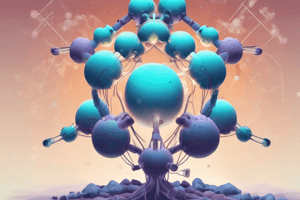Podcast
Questions and Answers
What is the primary characteristic that distinguishes a mixture from a compound?
What is the primary characteristic that distinguishes a mixture from a compound?
- The ability to be separated using physical methods (correct)
- The loss of chemical properties of the individual components
- The combination of substances in a fixed ratio
- The presence of multiple elements
Which of the following is NOT a characteristic of an element?
Which of the following is NOT a characteristic of an element?
- It is the building block of matter
- It has a fixed ratio of elements
- It consists of only one type of atom
- It can be broken down into simpler substances by chemical means (correct)
What is the primary difference between a homogeneous mixture and a heterogeneous mixture?
What is the primary difference between a homogeneous mixture and a heterogeneous mixture?
- The type of substances present in the mixture
- The composition of the mixture (correct)
- The physical properties of the mixture
- The chemical properties of the mixture
Which separation technique is based on the difference in boiling points of the substances in a mixture?
Which separation technique is based on the difference in boiling points of the substances in a mixture?
What is the state of matter characterized by particles that are widely spaced and have neither a fixed shape nor volume?
What is the state of matter characterized by particles that are widely spaced and have neither a fixed shape nor volume?
Which of the following is an example of a heterogeneous mixture?
Which of the following is an example of a heterogeneous mixture?
What is the primary purpose of chromatography as a separation technique?
What is the primary purpose of chromatography as a separation technique?
Which of the following is NOT a characteristic of a compound?
Which of the following is NOT a characteristic of a compound?
What is the state of matter characterized by particles that are closely packed and have a fixed shape and volume?
What is the state of matter characterized by particles that are closely packed and have a fixed shape and volume?
Which separation technique is based on the difference in particle size of the substances in a mixture?
Which separation technique is based on the difference in particle size of the substances in a mixture?
Flashcards are hidden until you start studying
Study Notes
Mixtures
- A mixture is a physical combination of two or more substances, where each substance maintains its chemical properties.
- Mixtures can be separated into their individual components using physical methods, such as filtration, sedimentation, or distillation.
- Types of mixtures:
- Homogeneous mixtures: uniform composition throughout, e.g. saltwater, air.
- Heterogeneous mixtures: non-uniform composition, e.g. sand and water, blood.
Compounds
- A compound is a substance formed by the chemical combination of two or more different elements, where each element loses its chemical properties.
- Compounds have a fixed ratio of elements, and their properties are different from those of their constituent elements.
- Examples: water (H2O), salt (NaCl), sugar (C6H12O6).
Elements
- An element is a substance that consists of only one type of atom, and cannot be broken down into simpler substances by chemical means.
- Elements are the building blocks of matter, and there are 118 known elements.
- Examples: hydrogen (H), carbon (C), oxygen (O).
States of Matter
- Solid: particles are closely packed, with a fixed shape and volume.
- Liquid: particles are close together but can move past each other, with a fixed volume but variable shape.
- Gas: particles are widely spaced, with neither a fixed shape nor volume.
- Plasma: a high-energy state of matter, where atoms are ionized and electrons are free to move.
Separation Techniques
- Filtration: separating a mixture based on particle size, using a filter or mesh.
- Sedimentation: separating a mixture based on density, where heavier particles settle to the bottom.
- Distillation: separating a mixture based on boiling point, where a liquid is heated and the vapor is collected.
- Chromatography: separating a mixture based on interactions between the substances and a stationary phase.
Special Types of Mixtures
- Colloid: a mixture where one substance is dispersed throughout another, with particles between 1-1000 nm in size, e.g. whipped cream, fog.
- Solution: a homogeneous mixture where one substance is dissolved in another, e.g. saltwater, sugar water.
Note: These notes provide a concise overview of the topics, focusing on key definitions and concepts.
Mixtures
- A mixture is a physical combination of two or more substances, where each substance maintains its chemical properties.
- Mixtures can be separated into their individual components using physical methods.
Types of Mixtures
- Homogeneous mixtures have a uniform composition throughout, examples include saltwater and air.
- Heterogeneous mixtures have a non-uniform composition, examples include sand and water, and blood.
Compounds
- A compound is a substance formed by the chemical combination of two or more different elements, where each element loses its chemical properties.
- Compounds have a fixed ratio of elements, and their properties are different from those of their constituent elements.
- Examples of compounds include water (H2O), salt (NaCl), and sugar (C6H12O6).
Elements
- An element is a substance that consists of only one type of atom, and cannot be broken down into simpler substances by chemical means.
- Elements are the building blocks of matter, and there are 118 known elements.
- Examples of elements include hydrogen (H), carbon (C), and oxygen (O).
States of Matter
- Solids have particles that are closely packed, with a fixed shape and volume.
- Liquids have particles that are close together but can move past each other, with a fixed volume but variable shape.
- Gases have particles that are widely spaced, with neither a fixed shape nor volume.
- Plasmas are high-energy states of matter, where atoms are ionized and electrons are free to move.
Separation Techniques
- Filtration separates a mixture based on particle size, using a filter or mesh.
- Sedimentation separates a mixture based on density, where heavier particles settle to the bottom.
- Distillation separates a mixture based on boiling point, where a liquid is heated and the vapor is collected.
- Chromatography separates a mixture based on interactions between the substances and a stationary phase.
Special Types of Mixtures
- Colloids are mixtures where one substance is dispersed throughout another, with particles between 1-1000 nm in size, examples include whipped cream and fog.
- Solutions are homogeneous mixtures where one substance is dissolved in another, examples include saltwater and sugar water.
Studying That Suits You
Use AI to generate personalized quizzes and flashcards to suit your learning preferences.




